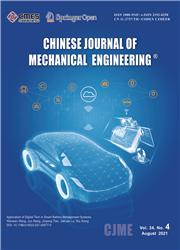基于多模态数据的人体数字孪生模型构建及其在运动模式识别中的应用
IF 4.5
2区 工程技术
Q1 Engineering
引用次数: 0
摘要
随着人们对智能制造中人的状态和作用的日益关注,关注人机交互的人-网络-物理系统(HCPS)的需求日益强烈。现有的智能制造系统不能满足高效的人机协同工作。然而,与配备传感器的机器不同,人的特征信息很难被即时感知和数字化。针对人体的高度复杂性和不确定性,提出了一种基于多模态数据的人体数字孪生(HDT)模型构建框架,并对其中的关键技术进行了阐述。建立数据采集系统,动态获取和更新人体的身体状态数据和生理数据,实现多源异构人体信息的数字化表达。设计了一种基于双向长短期记忆和卷积神经网络(BiLSTM-CNN)的多模态人体数据融合与时空特征提取网络,并以人体运动模式识别为应用实例。为了提高所提出的基于bilstm - cnn的网络模型的性能,进行了一系列优化实验。将该模型与传统的运动模式识别模型进行了比较。实验结果证明了HDT框架在人体运动模式识别中的优越性。本文章由计算机程序翻译,如有差异,请以英文原文为准。
Construction of Human Digital Twin Model Based on Multimodal Data and Its Application in Locomotion Mode Identification
Abstract With the increasing attention to the state and role of people in intelligent manufacturing, there is a strong demand for human-cyber-physical systems (HCPS) that focus on human-robot interaction. The existing intelligent manufacturing system cannot satisfy efficient human-robot collaborative work. However, unlike machines equipped with sensors, human characteristic information is difficult to be perceived and digitized instantly. In view of the high complexity and uncertainty of the human body, this paper proposes a framework for building a human digital twin (HDT) model based on multimodal data and expounds on the key technologies. Data acquisition system is built to dynamically acquire and update the body state data and physiological data of the human body and realize the digital expression of multi-source heterogeneous human body information. A bidirectional long short-term memory and convolutional neural network (BiLSTM-CNN) based network is devised to fuse multimodal human data and extract the spatiotemporal features, and the human locomotion mode identification is taken as an application case. A series of optimization experiments are carried out to improve the performance of the proposed BiLSTM-CNN-based network model. The proposed model is compared with traditional locomotion mode identification models. The experimental results proved the superiority of the HDT framework for human locomotion mode identification.
求助全文
通过发布文献求助,成功后即可免费获取论文全文。
去求助
来源期刊

Chinese Journal of Mechanical Engineering
ENGINEERING, MECHANICAL-
CiteScore
5.60
自引率
4.80%
发文量
3097
审稿时长
8 months
期刊介绍:
Chinese Journal of Mechanical Engineering (CJME) was launched in 1988. It is a peer-reviewed journal under the govern of China Association for Science and Technology (CAST) and sponsored by Chinese Mechanical Engineering Society (CMES).
The publishing scopes of CJME follow with:
Mechanism and Robotics, including but not limited to
-- Innovative Mechanism Design
-- Mechanical Transmission
-- Robot Structure Design and Control
-- Applications for Robotics (e.g., Industrial Robot, Medical Robot, Service Robot…)
-- Tri-Co Robotics
Intelligent Manufacturing Technology, including but not limited to
-- Innovative Industrial Design
-- Intelligent Machining Process
-- Artificial Intelligence
-- Micro- and Nano-manufacturing
-- Material Increasing Manufacturing
-- Intelligent Monitoring Technology
-- Machine Fault Diagnostics and Prognostics
Advanced Transportation Equipment, including but not limited to
-- New Energy Vehicle Technology
-- Unmanned Vehicle
-- Advanced Rail Transportation
-- Intelligent Transport System
Ocean Engineering Equipment, including but not limited to
--Equipment for Deep-sea Exploration
-- Autonomous Underwater Vehicle
Smart Material, including but not limited to
--Special Metal Functional Materials
--Advanced Composite Materials
--Material Forming Technology.
 求助内容:
求助内容: 应助结果提醒方式:
应助结果提醒方式:


